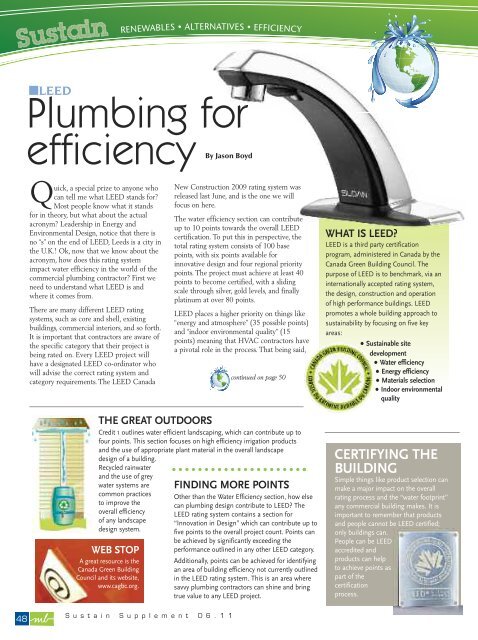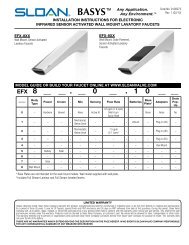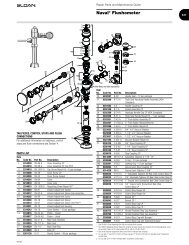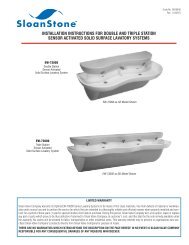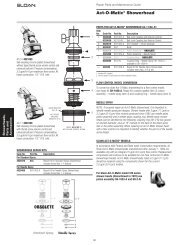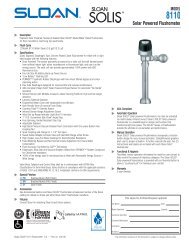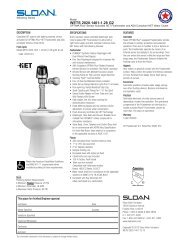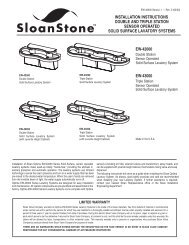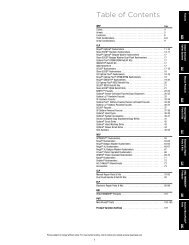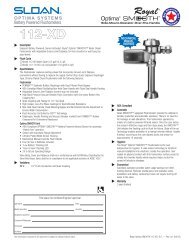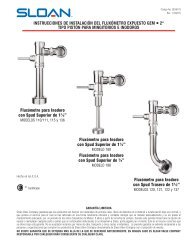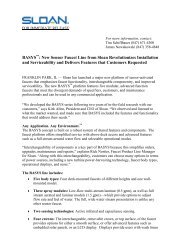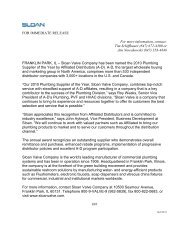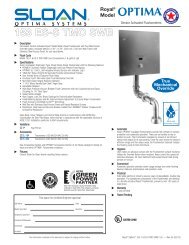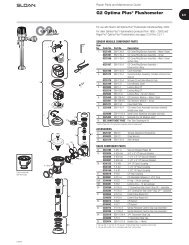Plumbing for Efficiency | Mechanical Business - Sloan Valve Company
Plumbing for Efficiency | Mechanical Business - Sloan Valve Company
Plumbing for Efficiency | Mechanical Business - Sloan Valve Company
You also want an ePaper? Increase the reach of your titles
YUMPU automatically turns print PDFs into web optimized ePapers that Google loves.
■LEED<br />
<strong>Plumbing</strong> <strong>for</strong><br />
efficiency<br />
By Jason Boyd<br />
Quick, a special prize to anyone who<br />
can tell me what LEED stands <strong>for</strong>?<br />
Most people know what it stands<br />
<strong>for</strong> in theory, but what about the actual<br />
acronym? Leadership in Energy and<br />
Environmental Design, notice that there is<br />
no “s” on the end of LEED, Leeds is a city in<br />
the U.K.! Ok, now that we know about the<br />
acronym, how does this rating system<br />
impact water efficiency in the world of the<br />
commercial plumbing contractor? First we<br />
need to understand what LEED is and<br />
where it comes from.<br />
There are many different LEED rating<br />
systems, such as core and shell, existing<br />
buildings, commercial interiors, and so <strong>for</strong>th.<br />
It is important that contractors are aware of<br />
the specific category that their project is<br />
being rated on. Every LEED project will<br />
have a designated LEED co-ordinator who<br />
will advise the correct rating system and<br />
category requirements. The LEED Canada<br />
New Construction 2009 rating system was<br />
released last June, and is the one we will<br />
focus on here.<br />
The water efficiency section can contribute<br />
up to 10 points towards the overall LEED<br />
certification. To put this in perspective, the<br />
total rating system consists of 100 base<br />
points, with six points available <strong>for</strong><br />
innovative design and four regional priority<br />
points. The project must achieve at least 40<br />
points to become certified, with a sliding<br />
scale through silver, gold levels, and finally<br />
platinum at over 80 points.<br />
LEED places a higher priority on things like<br />
“energy and atmosphere” (35 possible points)<br />
and “indoor environmental quality” (15<br />
points) meaning that HVAC contractors have<br />
a pivotal role in the process. That being said,<br />
continued on page 50<br />
WHAT IS LEED?<br />
LEED is a third party certification<br />
program, administered in Canada by the<br />
Canada Green Building Council. The<br />
purpose of LEED is to benchmark, via an<br />
internationally accepted rating system,<br />
the design, construction and operation<br />
of high per<strong>for</strong>mance buildings. LEED<br />
promotes a whole building approach to<br />
sustainability by focusing on five key<br />
areas:<br />
• Sustainable site<br />
development<br />
• Water efficiency<br />
• Energy efficiency<br />
• Materials selection<br />
• Indoor environmental<br />
quality<br />
THE GREAT OUTDOORS<br />
Credit 1 outlines water efficient landscaping, which can contribute up to<br />
four points. This section focuses on high efficiency irrigation products<br />
and the use of appropriate plant material in the overall landscape<br />
design of a building.<br />
Recycled rainwater<br />
and the use of grey<br />
water systems are<br />
common practices<br />
to improve the<br />
overall efficiency<br />
of any landscape<br />
design system.<br />
WEB STOP<br />
A great resource is the<br />
Canada Green Building<br />
Council and its website,<br />
www.cagbc.org.<br />
FINDING MORE POINTS<br />
Other than the Water <strong>Efficiency</strong> section, how else<br />
can plumbing design contribute to LEED? The<br />
LEED rating system contains a section <strong>for</strong><br />
“Innovation in Design” which can contribute up to<br />
five points to the overall project count. Points can<br />
be achieved by significantly exceeding the<br />
per<strong>for</strong>mance outlined in any other LEED category.<br />
Additionally, points can be achieved <strong>for</strong> identifying<br />
an area of building efficiency not currently outlined<br />
in the LEED rating system. This is an area where<br />
savvy plumbing contractors can shine and bring<br />
true value to any LEED project.<br />
CERTIFYING THE<br />
BUILDING<br />
Simple things like product selection can<br />
make a major impact on the overall<br />
rating process and the “water footprint”<br />
any commercial building makes. It is<br />
important to remember that products<br />
and people cannot be LEED certified;<br />
only buildings can.<br />
People can be LEED<br />
accredited and<br />
products can help<br />
to achieve points as<br />
part of the<br />
certification<br />
process.<br />
48<br />
S u s t a i n S u p p l e m e n t 0 6 . 1 1
Jason Boyd is the LEED-accredited marketing manager <strong>for</strong> Dobbins Sales.<br />
He can be reached at jboyd@dobbinsales.com.<br />
REDUCING WATER USE<br />
The water use reduction prerequisite of LEED is based on a<br />
simple <strong>for</strong>mula showing approximate usage in a building on<br />
an annual basis, calculated against a standard baseline<br />
per<strong>for</strong>mance. The baseline <strong>for</strong> commercial<br />
toilets is 6 litres per flush; commercial urinals<br />
is 3.8 litres per flush; private lavatory<br />
applications (hotel/motel or hospital<br />
patient rooms) is 8.3 litres per minute;<br />
other commercial lavatory faucets is 1.9<br />
litres per minute; 0.95 litres per cycle <strong>for</strong><br />
metering faucets; 9.5 litres per minute <strong>for</strong><br />
commercial showerheads; and, finally, a flow<br />
rate equal to or less than 6.0 litres per minute<br />
<strong>for</strong> food service pre-rinse appliances.<br />
Things like commercial clothes or dish washers are<br />
excluded from the water efficiency calculations.<br />
By installing High <strong>Efficiency</strong> Toilets (HETs) and High<br />
<strong>Efficiency</strong> Urinals (HEUs) it becomes very easy to achieve<br />
the required percentage of water savings and gain the<br />
maximum number of points available in credit 3, (see<br />
page 50) water use reduction. Most manufacturers now<br />
offer things like 4.8 litre per flush commercial toilets, dual<br />
flush commercial toilet packages and HEUs that can<br />
deliver as little as 0.47 litres per flush. Another option to<br />
help achieve water use reduction points are water-free<br />
urinals, which have become more common over the past<br />
several years.<br />
Low-flow showerheads, faucet aerators, metering faucets<br />
and low consumption pre-rinse units all factor into the<br />
calculations, and can contribute to the overall water<br />
savings in any building. This is sometimes where people<br />
can confuse the fact that all of these high efficiency<br />
products are not LEED certified but merely assist in<br />
lowering overall potable water usage.
continued from page 48<br />
when budgets and the green design<br />
process collide, every possible point is<br />
critical – meaning water efficiency is<br />
never overlooked, and can often be<br />
easier and less costly to achieve.<br />
Here is how the water efficiency<br />
section is broken down:<br />
PREREQUISITE 1 – water use<br />
reduction of 20% vs. Baseline<br />
CREDIT 1 – water efficient<br />
landscaping: Up to 4 points<br />
CREDIT 2 - innovative wastewater<br />
technologies: Up to 2 points<br />
WATER INNOVATION<br />
Grey water use leads into Credit 2, innovative waste water technologies<br />
<strong>for</strong> up to two points. To achieve these points the building design must<br />
reduce potable water use <strong>for</strong> building sewage conveyance by 50 per cent<br />
through the use of water-conserving fixtures (e.g., water closets, urinals)<br />
or non-potable water (e.g., captured rainwater, recycled greywater, and<br />
on-site or municipally treated wastewater).<br />
A second option would be to treat 50 per cent of wastewater on-site to<br />
tertiary standards. Treated water must be infiltrated or used on-site.<br />
In the realm of readily available and promoted commercial products,<br />
this area lags behind the use of HETs and HEUs to achieve water use<br />
reduction points in Credit 3. It is a rapidly growing area though and as<br />
more and more greywater systems become approved <strong>for</strong> sale in the<br />
Canadian market we will see an increase in execution on this credit area.<br />
CREDIT 3 – water use reduction:<br />
Up to 4 points<br />
All of the requirements outlined in the<br />
water efficiency section of the LEED rating<br />
system really should come down to sensible<br />
plumbing practices with an eye to<br />
preserving this valuable resource.<br />
And water preservation really should be a<br />
core value <strong>for</strong> any build, whether it is a<br />
LEED project or not. There is no more<br />
work or cost associated with installing a 6.0<br />
litre per flush fixture and flush valve versus<br />
a 4.8 lpf version. Same goes <strong>for</strong> a 3.8 lpf<br />
urinal versus the 0.47 version. All it takes is<br />
a little bit of awareness about the products<br />
that are available and a desire to preserve<br />
water <strong>for</strong> the future.


